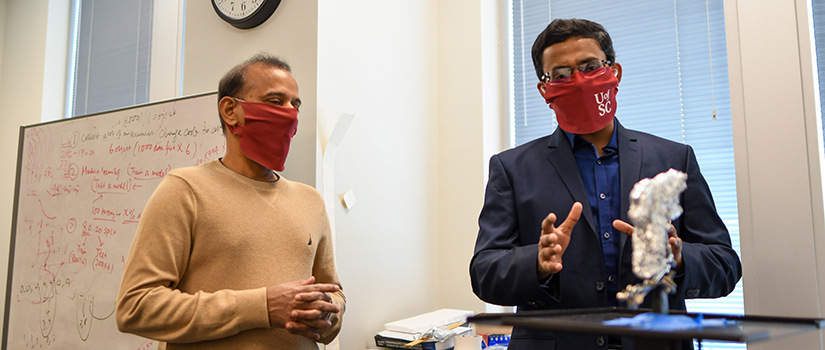Study is expected to advance interdisciplinary research on “smart and connected things”
By Leigh Thomas | November 18, 2020
Through a grant from the National Science Foundation, researchers from the University of South Carolina have embarked on a cutting-edge study that focuses on identifying the most accurate form of measurement, called “ground truth.” The knowledge gained will advance research across all areas of the university involved in the field of smart and connected things.
“Smart and connected things” are products embedded with processors, sensors, software and connectivity that allow data to be exchanged between a product and its environment or other systems. However, in order for researchers to train algorithms and devise communication schemes within these devices, it is necessary to first find ground truth.
The half-million-dollar grant allows for acquisition of an Omnipercipient Chamber (OmniC), a 1,000 square foot “room” that will be equipped with a variety of antennas, sensors and cameras. The OmniC will identify ground truth by capturing minute details with high precision across the frequency spectrum. Principal Investigator Srihari Nelakuditi of the College of Engineering and Computing is leading a team of co-investigators that includes Guoan Wang, Nikolaos Vitzilaios, Stacy Fritz and Sanjib Sur.
“The idea of ground truth is a true measure. It’s not easy to get to ground truth manually," Nelakuditi says. "The idea of the ‘omni’ chamber is that it sees everything.”
Fritz says, “One of the most exciting things about this is the interdisciplinary aspect. Srihari put together a great team to say ‘what can we use this for?’ Ground truth is the gold standard of measure, and having the means to identify it leverages the common needs of research groups across a number of disciplines.”
Some of those research efforts include monitoring gait for therapeutic and rehabilitation care, devising next-generation wireless protocols and systems, miniaturizing and characterizing wireless antennas, and coordinating and navigating drones for safe delivery.
Nelakuditi explains that the OmniC could be used to track a person’s motion to measure gait, for example. Researchers can monitor motion and infer gait by placing Wi-Fi access points in a patient’s home, which will detect movement and impact signals. Through the effect of motion on signal reception, they can infer motion and where feet are landing.
“Through this all-seeing chamber, we can track every detail about motion and extract data through changes in signal. Then we can truly analyze gait and see who is doing well and not so well,” Nelakuditi says.
Fritz says, “One-third of older adults fall, often leading to hospitalization and long-term care. We want to minimize that, and we do so by evaluating movement, such as walking speed, and making predictions. When we measure in a clinic, it’s a one-time view. By measuring in the home we can improve prediction and therefore better assess whether we need to intervene.”
According to Sur, an assistant professor in the college, the OmniC will also impact the next generation of wireless technology.
“We’re looking beyond current technology, such as 4G and 5G, to how we can impact 6G," he says. "The chamber will be able to change the properties of a wireless signal, acting like a mirror to bend the signal to a precise location. Right now Wi-Fi works at low frequency with limited speed. In the future a live sensor will capture signals and bend them to a person’s location to achieve very high speed reliably.”
Ultimately, the OmniC is expected to reduce the cost and effort of conducting research, further interdisciplinary collaborations and improve the speed and accuracy of scientific advancement. Sur said, “The main benefit is how broad the scope of the OmniC really is.”
The team’s research is expected to conclude in 2023.
Stacy Fritz is a professor of exercise science in the Arnold School of Public Health. Her current research interests include gait analysis in older adults using floor vibrations and the importance of physical activity for those who have decreased functional movement due to acquired neurological injury.
Sanjib Sur is an assistant professor of computer science and engineering in the College of Engineering and Computing. His research interests are in the areas of wireless systems and architectures, millimeter-wave communications and networks and internet of things connectivity and sensing systems.
Srihari Nelakuditi is a professor of computer science and engineering in the College of Engineering and Computing. His research interests are in the areas of mobile computing, wireless networking and internet routing.
